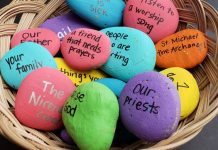
SHELIA KEARNEY
At this time of year, our thoughts, time, and energy turn toward preparing for the holiday season. We pull out the treasured family Advent wreath, the box of precious holiday decorations, the favorite recipes, and, yes, the box marked “LIGHTS.” How can we possibly feel completely ready to enter the season if we haven’t put up the lights!
We associate the Advent season and the coming of Christmas with bright and colorful lights—lights in store and home windows, strung along the edge of rooftops, and draped around doorways. These lights are festive and have the power to lift our spirits.
But there are other lights during this time, lights that shine more brightly than the ones on display. These are the lights of our prayer, service, and love that mark our Catholic faith.
This Advent season, share with your students the special Lights of Advent. Help your students’ inner lights shine by doing one or all of the following activities: the Light of Prayer, the Light of Service, the Light of Love.
The Light of Prayer
Begin your Advent Season with the Light of Prayer. During the prayer, students will add figures to the stable, where the figures will remain throughout the Advent Season.
You will need the figures and creatures of a nativity scene, the empty stable, ten students to read, and the prayer below (or you may want to make one copy of the prayer, cut the Reader parts into strips, and give one to each student who will be a Reader).
Leader: Advent is a time of waiting and preparing. In our daily lives, we’re very familiar with waiting and preparing: We wait and prepare for our family vacation; we wait and prepare for the big test or the science fair or the soccer tournament; we wait and prepare for big family events. Yes, we know about waiting and preparing.
Advent is a time to wait and prepare. We wait for the coming of Christ and we prepare our hearts to receive him always—in the Eucharist, in one another, and at the time of his coming in glory.
Let’s reflect on that first Christmas and imagine what it was like for those waiting and preparing for the coming of the Messiah. Let our prayer be that we, too, might wait and prepare to receive Jesus—during the season of Advent and always—in his glory when he comes, in the Eucharist, in others.
(Have one student bring forward the figure of Mary to the prayer table and place her in an appropriate place in the stable.)
Reader One: The birth of a new baby in a family brings great joy, planning, and much love. Mary’s heart was full of love as she waited and prepared for the birth of her baby, making sure her baby would have blankets and clothes.
Reader Two: Help us, Lord, to be like Mary, to be joyful in the coming of Jesus and to prepare our hearts to give him a warm welcome—during the season of Advent and always.
All: Oh Lord, help us to get our hearts ready for Christmas.
(Have one student bring the figure of Joseph to the prayer table and place him in an appropriate place in the stable.)
Reader Three: Joseph was a carpenter. His heart was full of love as he waited and prepared for the birth of Jesus, making a safe and secure home, making a place for the baby to sleep.
Reader Four: Help us, Lord, to be like Joseph, to build a world of peace, starting right in our own homes—during the season of Advent and always.
All: Oh Lord, help us to get our hearts ready for Christmas.
(Have a student bring the figure(s) of the shepherd(s) to the prayer table and place him/them in an appropriate place near the stable.)
Reader Five: The shepherds in the field were loving and dependable people. They knew it was important to protect the sheep. They were faithful to their task.
Reader Six: Help us, Lord, to be faithful disciples of your Son, Jesus—during the season of Advent and always.
All: Oh Lord, help us to get our hearts ready for Christmas.
(Have a student bring the figure of the angel to the prayer table and place the angel in an appropriate place in the stable.)
Reader Seven: The angels filled the whole heavens with glory and praise in proclaiming the birth of the Messiah, the Son of God, the Savior of the World.
Reader Eight: Help us, Lord, to fill ourselves, our families, our friends, and the whole world with the love and peace of your Son, Jesus—during the season of Advent and always.
All: Oh Lord, help us to get ready our hearts ready for Christmas.
(Bring the figures of the wise men to the prayer table and place them in an appropriate place near the stable.)
Reader Nine: The wise men traveled from faraway places and faced many dangers to find the newborn king and to give him precious gifts.
Reader Ten: Help us, Lord, to seek for ways to share the gift of your Son, Jesus, knowing that everything we do for others we do for Jesus—during the season of Advent and always.
All: Oh Lord, help us to get our hearts ready for Christmas. Amen.
(Before the children return for the first class after your Christmas break, place the figure of the infant Jesus in the stable.)
The Light of Service
The Advent Season brings a wide variety of service opportunities. Many youngsters may have had service experiences with their families or classmates when they participated in projects organized by parish outreach ministries. They may have worked in food pantries, collected clothing and other items for those in need, helped with social justice programs, etc. The Light of Service is a project that the older elementary students (fourth, fifth, and sixth grade) can organize and execute on their own for younger students (kindergarten through third grade), with your help.
Have older students provide a Christmas Store for younger students. This is bound to be a huge success among the young children, their families, and those youngsters who organize and operate the store. This experience benefits your parish in many ways. It offers older elementary students the experience of planning, organizing, and executing a short-term project for the good of others; it gives younger children the opportunity to “shop” in a safe environment; the proceeds are contributed to an existing parish outreach program.
You will need a location for the Christmas Store. This is where the younger children will shop and where the store’s inventory can be secure over a period of several weeks. (This may be your own classroom space.) You will need to schedule the store hours so that both the older and the younger children will be in the same area at the same time—perhaps during one of your regularly scheduled faith formation class times. (Let parents of younger children know ahead of time when the store is going to be open so that they can be sure their young children have money.) You will need items for the store, to be collected by the older children. (Have students think in terms of small and simple items—bearing in mind the kinds of things they may have given their parents and siblings and other family members when they were younger. These items need not be new. They may even be things the older students can easily craft during a class session, such as beaded necklaces or key chains, bookmarks, simple tree ornaments, etc.)
During shopping hours young children enter the Christmas Store and drop into decorated containers the amount of money they wish to spend. Each young shopper tells a waiting clerk (an older student) the number of family members for which he or she is shopping, and then the clerk helps the young shopper find his or her way around the store. (We limited our young shoppers to one gift per person on their lists. This made it possible for every child to have the benefit of a wide variety of “gifts” from which to select. Once every child had shopped, we invited all of them to browse and shop more, if they wanted.)
To prepare for the experience, explain to older students how the Christmas Store works and their responsibility to collect items for the store and be clerks at the store. They also will have to determine prices for the items. (We did not put a price sticker on each item. Instead, we grouped things in price categories and used colored stickers to indicate the cost so that clerks at the checkout knew what each item cost. We priced nothing less than a quarter and nothing more than $1.00, always keeping in mind that the goal and purpose are the rewards of the experience for the students—not the goal of fundraising.)
Be sure to build a lesson around the Light of Service for the older students. Explain the importance of service and allow students to share and discuss times when they have participated in service projects. Encourage students to share their “before” and “after” experiences of these activities. Use open-ended questions to help foster classroom discussions: Why did you select that particular activity of service? How did that project help others? What impact did the project have on you? What surprised you most about your experience? What did you learn about compassion, generosity, and service in the name of Jesus?
Emphasize the importance of this “shopping” experience for the younger children and the service provided them through the Christmas Store. You might want to remind your students of the importance of giving and the excitement they themselves have felt when they got to give something special to a loved one. Be sure to include a discussion about parish outreach programs and to whom the proceeds from the Christmas Store might be donated.
The Light of Love
This Light of Love activity helps your students express love in simple ways. It is based on the popular “secret Santa” or “secret angel” activity. The main difference in this Light of Love activity is that the giver is not a secret—unless he or she prefers to be. Those who receive “love lights” know from whom the gift has come.
You will need at least a dozen paper candles for each student (Do a web search for coloring pages for candles. There are many you can download and copy as many as you would like and cut them out ahead of time). You will need pens or fine-tipped markers. You might also like to have on hand small religious or Christmas stickers.
To prepare for the experience, talk with your students about Advent being a time of waiting and preparing. Explain how the lights that we see all around us during the Advent Season remind us of how Jesus came into a dark world of sin to bring the light of love and salvation. Read John 1:1-9 (from the Gospel proclaimed on Christmas Day).
Explain that some of the most treasured and memorable gifts we give or receive take the shape of words sometimes followed with actions. Give each student at least a dozen candles and explain that these lights of love are simple, quiet, bright gifts they can give to family members and friends. Students can write messages of care and love on the candles and decorate them during class, or they can take them home and write on them as various situations arise. Lights of love might say “Have a great day,” “I am praying for you today,” “You are a wonderful person,” “I’m so glad you are my __(mom, dad, etc.)__,” “What can I do today to help you?”
Tell the children to place their lights of love in unusual places where receivers are sure to find them: in Dad’s shoe; in Mom’s coffee cup; on Grandma’s pillow; taped to a friend’s locker, etc. Emphasize the importance of keeping the lights of love genuine and simple. Family members and friends certainly will cherish their lights of love. They may enjoy them so much that they hang their lights of love like ornaments on the Christmas tree.
Sheila Kearney has taught in Catholic schools for more than 30 years. She currently teaches at St. Raphael’s Catholic School in Crystal, MN.
This article originally appeared in Catechist magazine, October 2010.
Image Credit: Romolo Tavani, istock




